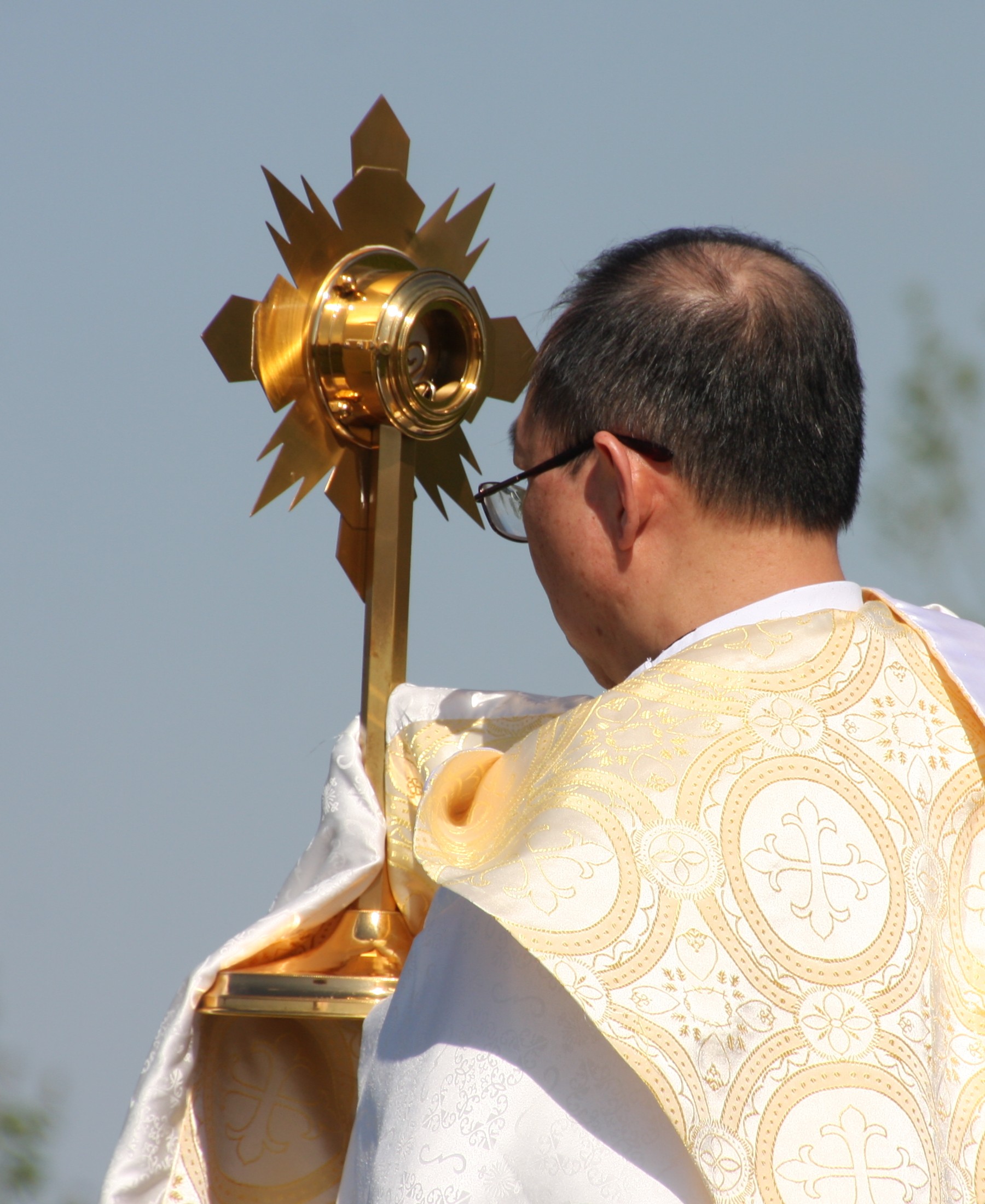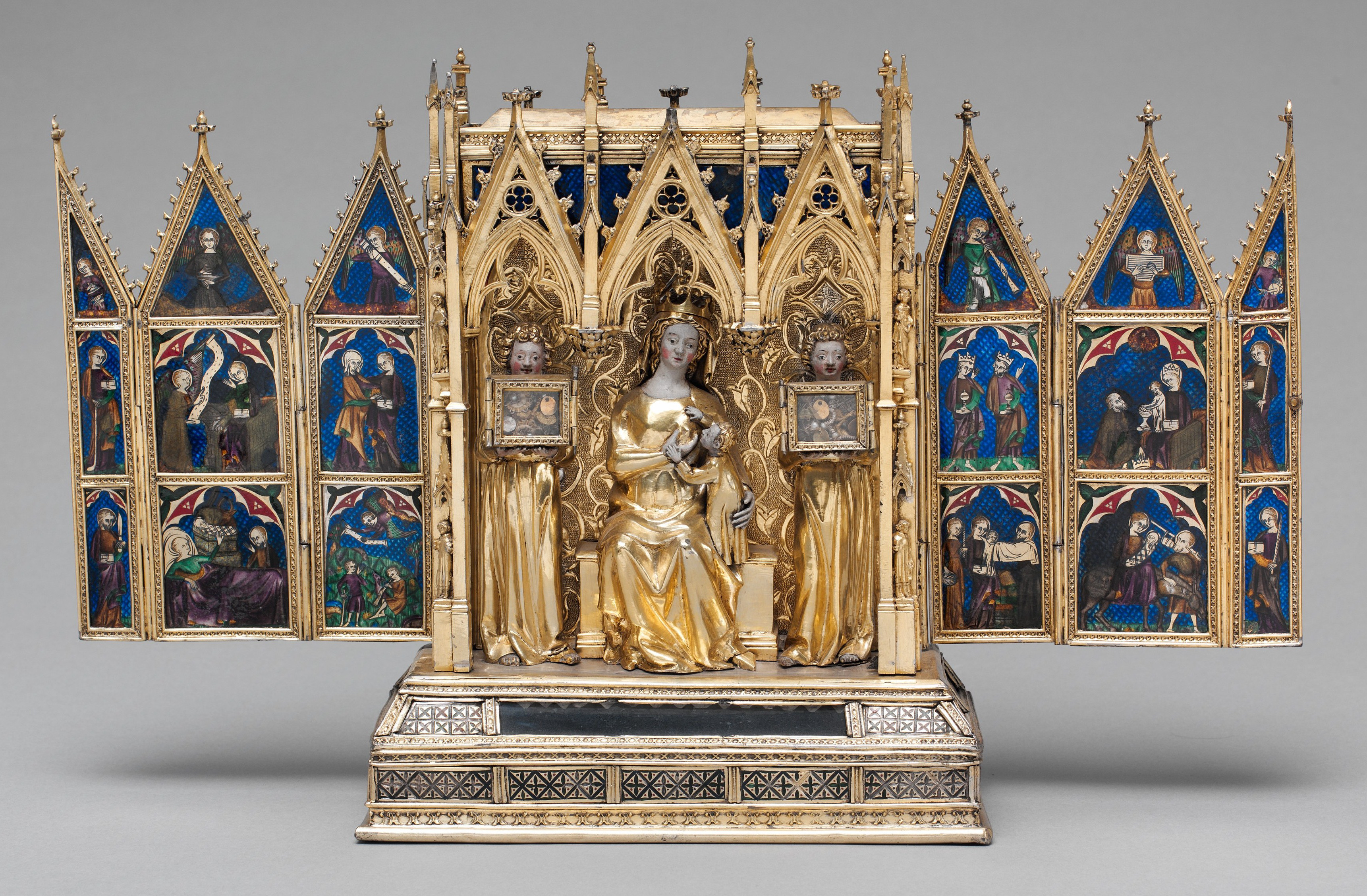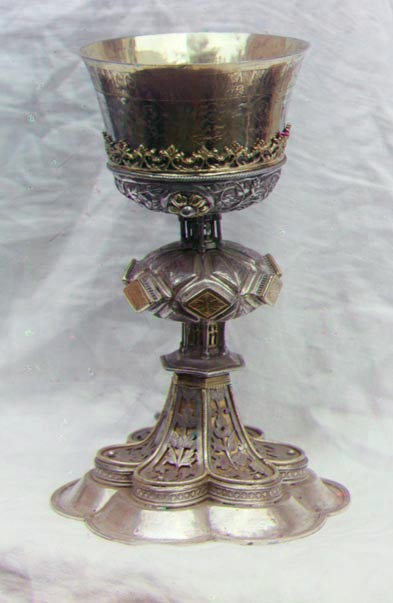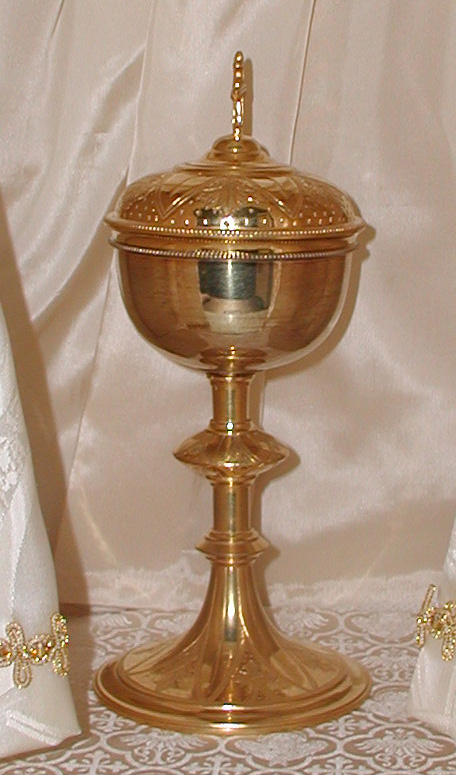|
Monstrance
A monstrance, also known as an ostensorium (or an ostensory), is a vessel used in Roman Catholic, Old Catholic, High Church Lutheran and Anglican churches for the display on an altar of some object of piety, such as the consecrated Eucharistic host during Eucharistic adoration or Benediction of the Blessed Sacrament. It is also used as reliquary for the public display of relics of some saints."" New Advent Catholic Encyclopedia. Retrieved on 2014-11-16. The word ''monstrance'' comes from the word ''monstrare'', while the word ''ostensorium'' came from the Latin word ''ostendere''. Both terms, meaning "to show", are used for vessels intended for the exposition of the Blessed Sacrament, but ''ostensorium'' has only t ... [...More Info...] [...Related Items...] OR: [Wikipedia] [Google] [Baidu] |
Benediction Of The Blessed Sacrament
Benediction of the Blessed Sacrament, also called Benediction with the Blessed Sacrament or the Rite of Eucharistic Exposition and Benediction, is a devotional ceremony, celebrated especially in the Roman Catholic Church, but also in some other Christian traditions such as Anglo-Catholicism, whereby a bishop, priest, or a deacon blesses the congregation with the Eucharist at the end of a period of adoration. Exposition before the blessing The actual benediction or blessing follows exposition of the Blessed Sacrament, i.e., the placing of the consecrated Host in a monstrance set upon the altar or at least exposition of a ciborium containing the Blessed Sacrament. Thus "the blessing with the Eucharist is preceded by a reasonable time for readings of the word of God, songs, prayers, and a period for silent prayer", while "exposition merely for the purpose of giving benediction is prohibited". The readings, songs and prayers are meant to direct attention to worship of Christ in the E ... [...More Info...] [...Related Items...] OR: [Wikipedia] [Google] [Baidu] |
Eucharist
The Eucharist (; from Greek , , ), also known as Holy Communion and the Lord's Supper, is a Christian rite that is considered a sacrament in most churches, and as an ordinance in others. According to the New Testament, the rite was instituted by Jesus Christ during the Last Supper; giving his disciples bread and wine during a Passover meal, he commanded them to "do this in memory of me" while referring to the bread as "my body" and the cup of wine as "the blood of my covenant, which is poured out for many". The elements of the Eucharist, sacramental bread ( leavened or unleavened) and wine (or non-alcoholic grape juice), are consecrated on an altar or a communion table and consumed thereafter, usually on Sundays. Communicants, those who consume the elements, may speak of "receiving the Eucharist" as well as "celebrating the Eucharist". Christians generally recognize a special presence of Christ in this rite, though they differ about exactly how, where, and when Chri ... [...More Info...] [...Related Items...] OR: [Wikipedia] [Google] [Baidu] |
Reliquary
A reliquary (also referred to as a '' shrine'', by the French term ''châsse'', and historically including '' phylacteries'') is a container for relics. A portable reliquary may be called a ''fereter'', and a chapel in which it is housed a ''feretory''. Relics may be the purported or actual physical remains of saints, such as bones, pieces of clothing, or some object associated with saints or other religious figures. The authenticity of any given relic is often a matter of debate; it is for that reason, some churches require documentation of the relic's provenance. Relics have long been important to Buddhists, Christians, Hindus and to followers of many other religions. In these cultures, reliquaries are often presented in shrines, churches, or temples to which the faithful make pilgrimages in order to gain blessings. The term is sometimes used loosely of containers for the body parts of non-religious figures; in particular the Kings of France often specified that their he ... [...More Info...] [...Related Items...] OR: [Wikipedia] [Google] [Baidu] |
Anima Christi
The "Anima Christi" (Latin for ‘Soul of Christ’) is a Catholic prayer to Jesus of medieval origin. History For many years the prayer was popularly believed to have been composed by Saint Ignatius of Loyola, as he puts it at the beginning of his ''Spiritual Exercises'' and often refers to it. In the first edition of the ''Spiritual Exercises'' Ignatius merely mentions it, evidently supposing that the reader would know it. In later editions, it was printed in full. It was by assuming that everything in the book was written by Ignatius that it came to be looked upon as his composition. On this account the prayer is sometimes referred to as the ''Aspirations of St. Ignatius Loyola''. However, the prayer actually dates to the early fourteenth century and was possibly written by Pope John XXII, but its authorship remains uncertain. It has been found in a number of prayer books printed during the youth of Ignatius and is in manuscripts which were written a hundred years befor ... [...More Info...] [...Related Items...] OR: [Wikipedia] [Google] [Baidu] |
Holy Spirit
In Judaism, the Holy Spirit is the divine force, quality, and influence of God over the Universe or over his creatures. In Nicene Christianity, the Holy Spirit or Holy Ghost is the third person of the Trinity. In Islam, the Holy Spirit acts as an agent of divine action or communication. In the Baha’i Faith, the Holy Spirit is seen as the intermediary between God and man and "the outpouring grace of God and the effulgent rays that emanate from His Manifestation". Comparative religion The Hebrew Bible contains the term " spirit of God" (''ruach hakodesh'') which by Jews is interpreted in the sense of the might of a unitary God. This interpretation is different from the Christian conception of the Holy Spirit as one person of the Trinity. The Christian concept tends to emphasize the moral aspect of the Holy Spirit more than Judaism, evident in the epithet Spirit that appeared in Jewish religious writings only relatively late but was a common expression in the Christi ... [...More Info...] [...Related Items...] OR: [Wikipedia] [Google] [Baidu] |
Corporal (liturgy)
The corporal (arch. ''corporax'', from Latin ''corpus'' "body") is a square white linen cloth, now usually somewhat smaller than the breadth of the altar, upon which the chalice and paten, and also the ciborium containing the smaller hosts for the Communion of the laity, are placed during the celebration of the Catholic Eucharist (Mass). History It may be assumed that something in the nature of a corporal has been in use since the earliest days of Christianity. Naturally it is difficult, based on the extant records from the early church, to distinguish the corporal from the altar-cloth. For instance, a passage of St. Optatus (c. 375), where he asks, "What Christian is unaware that in celebrating the Sacred Mysteries the wood f the altaris covered with a linen cloth?" (''ipsa ligna linteamine cooperiri'') leaves us in doubt to which he is referring. This is probably the earliest direct testimony; for the statement of the '' Liber Pontificalis'', "He ( Pope Sylvester I) dec ... [...More Info...] [...Related Items...] OR: [Wikipedia] [Google] [Baidu] |
Chalice (cup)
A chalice (from Latin 'mug', borrowed from Ancient Greek () 'cup') or goblet is a footed cup intended to hold a drink. In religious practice, a chalice is often used for drinking during a ceremony or may carry a certain symbolic meaning. Religious use Christian The ancient Roman ''calix'' was a drinking vessel consisting of a bowl fixed atop a stand, and was in common use at banquets. In Roman Catholicism, Eastern Orthodox Church, Oriental Orthodoxy, Anglicanism, Lutheranism and some other Christian denominations, a chalice is a standing cup used to hold sacramental wine during the Eucharist (also called the Lord's Supper or Holy Communion). Chalices are often made of precious metal, and they are sometimes richly enamelled and jewelled. The gold goblet was symbolic for family and tradition. Chalices have been used since the early church. Because of Jesus' command to his disciples to "Do this in remembrance of me." (), and Paul's account of the Eucharistic rite i ... [...More Info...] [...Related Items...] OR: [Wikipedia] [Google] [Baidu] |
Paten
A paten or diskos is a small plate, used during the Mass. It is generally used during the liturgy itself, while the reserved sacrament are stored in the tabernacle in a ciborium. Western usage In many Western liturgical denominations, the paten is typically either a simple saucer-like plate or a low bowl. A smaller style paten will often have a depression that allows it to securely sit on top of the chalice, as shown in the illustration on the left here. Roman rite The General Instruction of the Roman Missal lays down rules for patens: "Sacred vessels should be made from precious metal. If they are made from metal that rusts or from a metal less precious than gold, they should generally be gilded on the inside." However, provisions for vessels made from non-precious metals are made as well, provided they are "made from other solid materials which in the common estimation in each region are considered precious or noble." Some call the communion-plate a "paten", but the ... [...More Info...] [...Related Items...] OR: [Wikipedia] [Google] [Baidu] |
Ciborium (container)
A ciborium (plural ciboria; Medieval Latin ''ciborium'' (drinking cup), from the Ancient Greek κιβώριον ''kibōrion'', a type of drinking-cupOED.) is a vessel, normally in metal. It was originally a particular shape of drinking cup in Ancient Greece and Rome, but the word later came to refer to a large covered cup designed to hold hosts for, and after, the Eucharist, thus the counterpart (for the bread) of the chalice (for the wine). The word is also used for a large canopy over the altar of a church, which was a common feature of Early Medieval church architecture, now relatively rare. History The ancient Greek word referred to the cup-shaped seed vessel of the Egyptian water-lily ''nelumbium speciosum'' and came to describe a drinking cup made from that seed casing, or in a similar shape. These vessels were particularly common in ancient Egypt and the Greek East. The word "'ciborium'" was also used in classical Latin to describe such cups, although the only examp ... [...More Info...] [...Related Items...] OR: [Wikipedia] [Google] [Baidu] |
Latin
Latin (, or , ) is a classical language belonging to the Italic branch of the Indo-European languages. Latin was originally a dialect spoken in the lower Tiber area (then known as Latium) around present-day Rome, but through the power of the Roman Republic it became the dominant language in the Italian region and subsequently throughout the Roman Empire. Even after the fall of Western Rome, Latin remained the common language of international communication, science, scholarship and academia in Europe until well into the 18th century, when other regional vernaculars (including its own descendants, the Romance languages) supplanted it in common academic and political usage, and it eventually became a dead language in the modern linguistic definition. Latin is a highly inflected language, with three distinct genders (masculine, feminine, and neuter), six or seven noun cases (nominative, accusative, genitive, dative, ablative, and vocative), five declensions, four ... [...More Info...] [...Related Items...] OR: [Wikipedia] [Google] [Baidu] |
Mass (liturgy)
Mass is the main Eucharistic liturgy, liturgical service in many forms of Western Christianity. The term ''Mass'' is commonly used in the Catholic Church, in the Western Rite Orthodoxy, Western Rite Orthodox, in Old Catholic Church, Old Catholic, and in Independent Catholic churches. The term is used in some Lutheranism, Lutheran churches, as well as in some Anglicanism, Anglican churches. The term is also used, on rare occasion, by other Protestant churches. Other Christian denominations may employ terms such as ''Divine Service (Lutheran), Divine Service'' or ''service of worship, worship service'' (and often just "service"), rather than the word ''Mass''. For the celebration of the Eucharist in Eastern Christianity, including Eastern Catholic Churches, other terms such as ''Divine Liturgy'', ''Holy Qurbana'', ''Holy Qurobo'' and ''Badarak'' (or ''Patarag'') are typically used instead. Etymology The English noun ''mass'' is derived from the Middle Latin . The Latin word was ... [...More Info...] [...Related Items...] OR: [Wikipedia] [Google] [Baidu] |




.jpg)




